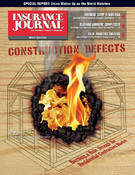The news that the market for lawyers’ liability coverage is softening may not be surprising but the questions that today’s insurance underwriters ask about law firm accounts might be, attendees at a recent Professional Liability Underwriting Society (PLUS) non-medical errors and omissions (E&O) symposium learned.
“Part of a broker’s job is to prevent surprises for the client but an underwriter will always ask something new,” commented Roger Marks, with Aon in New York, who likened the presentation of an insurance risk to a securities offering.
“The customer needs to know that the underwriter has to do due diligence that is much more complicated than the application,” he added during the Philadelphia forum.
Other PLUS participants included Michael Churchman of underwriter Navigators Pro in New York; Bill McLoughlin of reinsurer Transatlantic and Dennis Mullins, an attorney with Mendes & Mount of New York.
Navigator Pro’s Churchman and other panelists recommended that brokers hold face-to-face meetings with underwriters to review law firm accounts and involve the firm’s partners and management in the insurance process, although they acknowledged these meetings are difficult to arrange.
Mullins, with Mendes & Mount, noted that law firms need to be convinced to give their insurance broker as much time and attention as they give to a very large account, especially as their premiums grow.
Today’s underwriters want to know how a law firm is organized, how it defines itself, what its practice areas are, and where it derives its revenues. The structure of a firm’s partnership compensation is also important to an underwriter, as is the firm’s client population.
An underwriter inquiring into the client base is likely to ask whether the clients are short or long-term, what type of work they do, how big they are, and how long they have been in business.
Mullins noted that many of today’s corporate scandals involved companies like Enron “who most believed were blue-chip and solid.”
The partnership compensation package and the age of a law firm can influence whether the firm is taking on new clients and who they are, the panelists noted. So underwriters seek information on these matters.
Underwriters will ask what, if any, vetting procedures a firm follows when deciding whether to accept new clients and what the legal firm says in its engagement and disengagement letters, panelists agreed.
“Some underwriters say they are really insuring the quality of a law firm’s client base,” Marks explained.
The claims history of a potential insured must not be overlooked of course, according to these experts. But they stressed that an underwriter may care as much about how the law firm reacted to a claim than about the claim itself.
A law firm that has handled a claim well may actually be a good risk because management now values insurance and loss prevention more than before, the experts said.
“A law firm has to step up and own a claim, take responsibility, fire someone, learn some lessons,” Mullin said.
Marks said that it may take the “eye-opening” of a claim before a law firm pays close attention to its insurance relationships.
The broker’s job is to prepare the client for these informational demands by underwriters, panelists said. If this occurs, the brokers themselves may be surprised at one result.
“If they are prepared, then when they see the price, the clients are not as surprised,” Marks commented.
McLoughlin said he believes there is “quite a good appetite” for this line of business among reinsurers. Although there has been tightening, there remains a lot of capital available.
Mullins said a reinsurer asked to accept a lawyers E&O program would consider whether it fits in with its portfolio, considering its size or specialty. More importantly, he said, a reinsurer will consider the three Ts: the talent of the underwriting people; the trust the reinsurer has in the insurance company or program person; and the transparency or open exchange of information that exists between the underwriter and the reinsurer.
Panelists agreed that while there is pressure to lower prices, there are also more exclusions and tighter terms. One area of tightening is in the length of contracts, with multi-year E&O policies now considered a relic of years past; only one-year policies are underwritten in today’s market.
“The customer needs to know that the underwriter has to do due diligence that is much more complicated than the application.”
Topics New York Agencies Underwriting Reinsurance
Was this article valuable?
Here are more articles you may enjoy.


 Trump’s Bond Insurer Tells Judge Shortfall Is ‘Inconceivable’
Trump’s Bond Insurer Tells Judge Shortfall Is ‘Inconceivable’  JPMorgan Client Who Lost $50 Million Fortune Faces Court Setback
JPMorgan Client Who Lost $50 Million Fortune Faces Court Setback  Marsh McLennan Agency to Buy Fisher Brown Bottrell for About $316M
Marsh McLennan Agency to Buy Fisher Brown Bottrell for About $316M  Why New York’s Attorney General Objects to Trump’s Bond Insurer
Why New York’s Attorney General Objects to Trump’s Bond Insurer 


